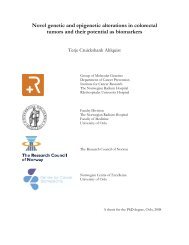Preface - Ous-research.no
Preface - Ous-research.no
Preface - Ous-research.no
You also want an ePaper? Increase the reach of your titles
YUMPU automatically turns print PDFs into web optimized ePapers that Google loves.
Molecular Cardiology<br />
Major Aim<br />
Dysfunctional cardiac signaling mechanisms and signals<br />
astray are considered major causes of pathologic myocardial<br />
hypertrophy and predisposition to heart failure. Increasingly,<br />
dysfunctional signaling mechanisms are implicated in<br />
increased production of free oxygen radicals, mitochondrial<br />
dysfunction and reduced tolerance to hypoxia and/or free<br />
oxygen radicals per se. Thus, the major goal of our <strong>research</strong><br />
group is to dissect the function of myocardial autocrine/<br />
paracrine factors, their cognate receptors, and intracellular<br />
pathways in cardiac myocytes and fibroblasts. New<br />
k<strong>no</strong>wledge on the function and mechanisms of signaling<br />
pathways in the heart may provide basis for development<br />
of new and more effective therapeutic intervention in acute<br />
coronary syndromes and heart failure.<br />
Current specific aims of the <strong>research</strong> group:<br />
1) Providing <strong>no</strong>vel insights into the function of myocardial G<br />
protein-coupled receptor kinases, i.e. a family of kinases that<br />
are important proximal modulators of many receptor-controlled<br />
signal transduction pathways involved in regulation<br />
of myocardial function in health and disease.<br />
2) Uncovering the function of myocardial autocrine/paracrine<br />
factors or cytokines that are activated or induced in<br />
heart failure. Current focus is on the secreted matricellular<br />
proteins CCN2/CTGF (connective tissue growth factor) and<br />
CCN5/WISP-2 (Wnt-inducible secreted protein-2), as well as<br />
the TGF-β superfamily cytokine GDF-15 in heart failure of<br />
various etiologies.<br />
Report from 2010:<br />
1) Investigation of substrate specificities and function of cardiac<br />
G protein-coupled receptor kinases (GRKs)<br />
We have previously investigated distribution of GRK2, GRK3,<br />
and GRK5 in myocardial tissue. These studies revealed that<br />
GRK2 was enriched in endothelial cells, whereas GRK3 was<br />
confined to cardiac myocytes. GRK5, on the other hand,<br />
was ubiquitously expressed among the cellular elements<br />
of myocardial tissue. The restricted distribution of GRK3 in<br />
cardiac myocytes clearly points to a role for this GRK isoform<br />
in regulation of G protein-coupled receptors on cardiac<br />
myocytes. However, since both GRK2 and GRK3 could be<br />
demonstrated in cardiac myocytes, studies of the substrate<br />
specificity of these kinases were an imminent issue. In isolated<br />
fully differentiated cardiac myocytes we investigated the<br />
substrate specificities of the GRK isoforms GRK2 and GRK3.<br />
These studies revealed that GRK2 and GRK3 display striking<br />
specificity on G protein-coupled receptors controlling different<br />
aspects of cardiac function. Overall, the present data<br />
have uncovered the <strong>no</strong>vel findings that GRK3 has substantially<br />
higher potency and efficacy than GRK2 at endoge<strong>no</strong>us<br />
endothelin receptors and α1-adrenergic receptors. This<br />
did <strong>no</strong>t seem to be the case for the β1-adrenergic receptor<br />
as GRK3 potency at this receptor appeared much weaker<br />
than for the ET-R, and was equipotent with GRK2. Thus,<br />
GRK3 emerges as a primary regulator of ET-R- and α1-ARsignaling,<br />
which may have important implications in cardiac<br />
function. The studies provide biochemical evidence of widely<br />
different functional roles of GRK2 and GRK3 in cardiac<br />
myocytes. These functional differences are currently subject<br />
of investigations in transgenic and gene-targeted mice.<br />
A recent <strong>no</strong>vel finding from our laboratory is that myocardial<br />
GRK5 is upregulated in transgenic CCN2/CTGF mice<br />
and causes reduced sensitivity of cardiac β-adrenergic<br />
receptors to endoge<strong>no</strong>us agonists. Furthermore, increased<br />
GRK5 initiates G protein-independent signaling by recruitment<br />
of β-arrestin to the receptor allowing ß-arrestin to<br />
act as a scaffolding protein for signaling complexes at the<br />
plasma membrane. Indeed, the altered signaling specificity<br />
of ERK1/2 initiated by GRK5 elicits cardioprotective actions.<br />
These findings have been recapitulated in cardiac myocytes<br />
pretreated with recombinant human CTGF. Yet, the signaling<br />
pathway(s) implicated in CTGF-induced GRK5 is yet to<br />
be characterized. Furthermore, the relative contribution<br />
of GRK5 to the cardioprotective actions afforded by CCN2/<br />
CTGF remains to resolved<br />
2) Role of CCN2 - connective tissue growth factor - in regulation<br />
of tolerance towards ischemia-reperfusion injury and in resisting<br />
maladaptive cardiac remodeling during chronic pressure<br />
overload.<br />
Myocardial CCN2 is highly expressed in the developing<br />
heart in fetal life and apparently plays crucial role in cardiac<br />
development. However, myocardial expression of CCN2 is<br />
repressed in the postnatal heart under physiologic conditions.<br />
Interestingly, myocardial expression of CCN2 is reactivated<br />
or induced during evolving heart failure. Previous<br />
findings from our laboratory demonstrate that induction<br />
of myocardial CCN2 appears to be a general response to<br />
evolving heart failure, i.e. induction of myocardial CCN2<br />
occurs in heart failure of diverse etiologies. Induction of<br />
tissue expression or increased plasma levels of CCN2 is often<br />
associated with diseases in which fibrosis is an important<br />
morphologic characteristic. However, to what extent CCN2/<br />
CTGF actually elicits fibrosis is yet to be demonstrated. Indeed,<br />
the physiologic and/or patho-physiologic functions of<br />
CCN2 in myocardial tissue have <strong>no</strong>t yet been resolved. Thus,<br />
a major focus of our <strong>research</strong> effort has been to elucidate<br />
the function of CCN2 in the heart. Does CCN2 exert salutary<br />
actions in heart failure or does CCN2 contribute to progres-<br />
16
















